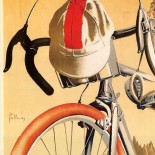Cycling Patents of Yesteryear: No. 9 – Rastetter and Siebold’s Child Seat Attachment for Bicyles, 1891
For many of us, our first experience of cycling, likely long forgotten, was not as a rider, but as a passenger, firmly ensconced in a child seat with an unimpeded view of our parents back. Carrying children on two-wheeled transport goes back further than the modern bicycle itself, to the days of the draisine. An 1817 illustration shows a child sitting behind an adult riding a Schwalbach velocipede, secured by a strap that passes around them both.
While the presumed parent clearly showed concern for the safety of their child, the strap and the panniers for the child’s feet were presumably not the most secure of arrangements. As the bicycle evolved from the draisine to the penny-farthing there appears to have been little development in designs for carrying children. The high-wheeler was precarious enough without an extra passenger, however small, and its frame did not lend itself to fixing a second seat to it.
The introduction of the safety bicycle in the 1880’s offered designers increased options to safely add a child seat to the triangular frame, and patents for child seats began to appear in the late 1880’s. An early example was the patent for a “Seat Attachment for Bicycles” submitted in 1891 by Louis Rastetter and Crist Siebold of Fort Wayne, Indiana.
Rastetter and Siebold’s design envisaged a removable child seat that was attached to the spring of the main seat, the steering fork, and the main frame of the bicycle. Adjustable foot rests were provided at both sides of the steering fork, and the handlebar, with its backward curve, would, “form a secure guard and prevent the child from falling out”.
The advantage of fixing the child seat in front of the rider was that they had sight of the child at all times. The disadvantage was that the child and the child seat could potentially obstruct the handlebars whilst steering. Many designs of this type were produced, and continue to be manufactured today. Other front mounted designs place the child in a seat mounted in front of the handlebars, an early example of which was submitted to the patent office in Britain by Daniel Albone, inventor of the Ivel Safety cycle, in the same year that Rastetter and Siebold secured their US patent.
Ultimately, the design that proved most successful placed the child in a seat over the rear wheel, as exemplified in an early 1898 example from Ernest F. Batchelder, which mounted a child’s saddle and a handlebar behind the main saddle, and provided footrests to keep wayward feet away from the wheel when in motion. Subsequent designs introduced better safety features in the form of backrests, side rails, and harnesses to secure the child in the seat, and guards to prevent feet and legs from being caught in the wheel.
Developments in rear mounted child seats had the advantage of increasing the safety of the child, whilst not unduly affecting the stability of the bicycle. The disadvantage is that the adult rider cannot see the child, or what they may be doing. While I was growing up my parents did not own a car, and some of my earliest memories are of being in a child seat on the back of my parents bicycles. Apparently, I used to help my parents when they would hand signal to indicate that they were turning left or right. Invariably, as they indicated left, I would indicate right, and as they indicated right, I would indicate left. Fortunately this never led to any major confusion for the traffic behind us.
______
Sources:
Louis Rastetter and Crist Siebold. Attachment for Bicycles. US Patent 460,031, filed June 23, 1891, and issued September 21, 1891.
Daniel Albone. Improvements in and Relating to Velocipedes. GB Patent 7,300, filed April 28, 1891, and accepted February 27, 1892.
Ernest F. Batchelder. Bicycle Attachment. US Patent 615,783, 1898, filed October 12, 1897, and issued December 13, 1898.
Tony Hadland and Hans-Erhard Lessing. “Child Seats”. In Bicycle Design: An Illustrated History. Cambridge, MA: MIT Press, 2014.





